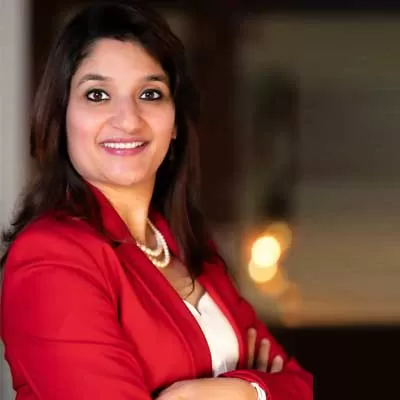An industry expert in climate technology and the renewable energy (RE) sector, Tanya Singhal’s entrepreneurial voyage took flight when she founded SolarArise, a solar asset management vehicle responsible for developing approximately half a GW of solar projects across seven states in India. Her leadership and influence extended beyond business operations as she collaborated with government and industry stakeholders to shape India’s RE policies through close collaboration with the Ministry of Renewable Energy. After eight years of leading SolarArise, she sold the firm and saw its growth on the London Stock Exchange. Next up has been Mynzo Carbon (MyNetZerO Carbon), which uses advanced technology to measure emissions and create a ‘climate-identity’ and offers personalised nudges to reduce the carbon footprint. And the loop is being closed by building My-Forest for carbon recapture to get to Net Zero. She shares her unique journey in conversation with Group Managing Editor FALGUNI PADODE and R SRINIVASAN. Excerpts:
Please take us through the genesis of SolarArise, Mynzo Carbon and My-Forest and your journey.
The answer connects three different eras of my life over the past 18 years. Also, the three moving parts of solar, climate consciousness and sequestration come from different eras. Brought up in Delhi, I went to IIT Delhi, did my engineering and then went on to join Boston Consulting Group [BCG] from 2007.
After having worked across sectors, the sustainability bug hit me. While working on infrastructure trends for India@75 with Professor CK Prahlad [NITI Aayog had released its Strategy for New India@75 document, outlining strategies across 41 areas to accelerate growth, achieve sustainable goals and reach a
$ 5-trillion economy by 2030. Professor CK Prahlad was the inspiration behind India@75], there were ports, roads and this shining star, renewables, on the top. I predicted renewables, specifically solar, will be cheaper than coal by 2020, when solar prices were Rs.18.7 a unit and coal was `3 a unit. So, solar was almost six times the price of coal and there was no solar policy in India.
When I asked my clients why they didn’t invest in this, they asked me, ‘Why don’t you do it?’ My family and co-founder (who I met at BCG) supported me and we started our first solar firm. We were doing solar thermal and the first four years were brutal because the cost curve didn’t come down. That was a pivotal time of my life because if I had left and returned to BCG, I wouldn’t have been talking to you today. But something kept me going – that’s when SolarArise was born. In 2014, I raised money from Kotak Mahindra’s managed Infrastructure fund – CIIF out of Singapore, and European Investment Bank’s (EIB) fund – GEEREF out of Luxembourg and we started building a solar PV IPP, a large-scale, ground-mounted solar company. Within SolarArise, we raised about `20 billion of capital. We built seven plants across different states in India and about half a GW portfolio. To give you a flavour, my smallest plant is about 200 football fields put together. Through this journey, my vision of getting solar cheaper than coal was achieved in 2015, which was five years before I had predicted it.
Last year, we decided that we had built a very sizeable portfolio and each of our projects was cash-generating, so we found a buyer who wanted to combine an Asia portfolio. Thus, SolarArise was one of the first Indian renewable energy (RE) firms to be listed on the London Stock Exchange (LSE) as a part of an Infrastructure Investment Trust (InvIT). The bigger achievement was that our investors got multi-fold returns for being among the very early people who believed in us.
Next, Mynzo….
Yes, after my exit, I took up Mynzo – MyNetZerO. It is a B2B2C solution used by corporates to engage their employees in their sustainability journey.
While renewables will go a long distance to get us to net zero, for any meaningful climate reversal change the masses should be involved. This is a problem for all of us and only by small actions that we all do, can we undo it. Today, people are at least talking about it and with the extreme weather events, heat, droughts, etc, it has become a top-of-the-mind agenda. But how do you make it second nature?
That is the driving force behind Mynzo, which starts by asking: ‘Do you know your carbon footprint?’ How can people reduce something they don’t know? So, they need a baseline. Now, you have your phone with you all the time and with AI, your phone can help you capture almost 70-80 per cent of your footprint. The app, available both on Playstore and AppStore for free, uses phone sensor data to automatically track your carbon footprint and you don’t have to enter any data manually. From the moment it is installed, it tracks everything, from your flight, car commute, electricity footprint, etc, and nudges you to do things differently with tailormade solutions for you, as each of us has a different carbon footprint. You can’t tell people to not have ACs, or not fly, or not eat. So, we try to figure out what you can do and then nudge you to do these subtle actions even more. But beyond a point, we can’t get to zero by just reduction because things will still run.
Thus, for the balance emissions, there’s an option to plant your own forest. This is where My-Forest, the third part of the value chain, comes in. Whatever extra you emit, you can pay to plant and maintain a set of trees, which is your own forest, which absorbs daily whatever you emit. You can track how many acres have been planted with live updates of your forest on the app! Earlier, a lot of corporates spent money every year to plant trees but they were not long-lived as nobody had any incentive to tend to them. In our solution, the land remains with villagers and farmers, they are given free saplings, manure etc and their incentive is that the forest produce is theirs. So, it’s an economic solution for them and they continue to care for it while the investor gets credit for the CO2 absorbed by the plantation – thus it is a circular economy concept.
The net profit margin in solar power is around 15-20 per cent, depending on the size and nature of the company. But after eight years of leading SolarArise, you successfully sold the firm to an InVit listed on LSE. What led to the decision to sell the business?
There were three core reasons that drove it. First, it showed that solar has established itself as a long term sustainable cash flow instrument and was ready for the public markets, almost like a fixed-income debt fund. Second, our investor’s (Kotak’s and EIB’s) fund had a ten-year life, typical of infrastructure funds, and were close to it. In addition, it was giving a multi-fold return on their original investments. The third reason was it put Indian solar assets on the global map through the LSE listing. I personally was also very happy to have built a firm that was ready to be a part of public markets. These three factors combined to, say, prove the business model, get my investors’ multi-fold returns, put Indian solar on the global map and drove me to take the opportunity.
What was the scope of work of SolarArise and how many projects did it involve? Also, which states are most profitable in view of solar?
SolarArise built approximately half a GW portfolio across 7 states: two projects in Karnataka, two in Telangana, one in Madhya Pradesh, one in Uttar Pradesh and one in Maharashtra. Project profitability depends on the PPA tariff, the site (solar radiation) and plant design.
You can’t say one state is more profitable than the others but there are certain parts in India where the overall solar radiation is very high [There is an India’s solar radiation map available that shows different colours at different places depending on radiation potential]. Areas of Telangana, the northern belt of Andhra Pradesh, Tamil Nadu, southern belt of Maharashtra, areas of Rajasthan, Gujarat and Kutch region have very strong solar radiation.
Solar projects are capital-intensive, and you end up spending almost 95 per cent of the investment even before operations start. Operation and Maintenance costs are relatively low and thus EBITDA margins are very high, and every unit of electricity generated almost directly goes to the bottom line.
Now, in these large solar plants ranging across 100s of acres, if you send an engineer to find a problem, you’ll be lost. It’s like trying to find a needle in a haystack! That’s where AI helps as it enables you to see which portion of the plant is working better than the rest. Similarly, in storage, it tells you when to store, what time of the day to generate, when to charge, when to discharge, etc. Earlier, it was solar technology, now it’s AI and ML technology that defines how you run your plants efficiently and get more juice out of it with the same amount of money you invested. The solar cost curve is already almost at rock bottom but efficiency still has a chance to go up.
You have received many accolades, such as ‘Person of the Year 2023’ and being one of ‘Asia’s Most Influential Women in Renewable Energy’ and ‘Power 100 - 2022, 2021, 2019’. How did getting these awards feel?
Entrepreneurship is a rollercoaster ride, where at times one may have more lows than highs. Every day is a test of persistence. You must guide yourself to keep walking, one step at a time, slowly inching towards your vision, not getting perturbed with the roadblocks coming your way.
While all these awards you have mentioned definitely feels nice, I cherish the journey that got me here because even if I had not got these awards, the amount of hard work I did would not have changed. So, while all these awards are good to get, the journey and achieving the vision of having solar cheaper than coal is worth much more for me.
Women account for about 11 per cent of the workforce in rooftop solar in India, which is lower than the global average of women in renewables at 32 per cent. What would you suggest to increase their presence in senior management?
It is very important to change the mindset, both outside and within, because I often feel that women by default curb themselves. There is so much bias that has been built in girls since childhood on what they can do and cannot do.
I was lucky that my family never constrained me that there were some roles I can’t do and always empowered me to do whatever I aspire. So when I told them I wanted to leave BCG to start an infrastructure firm, they unconditionally stood by me, even though some people heavily discouraged me that this was not a role for women and had too much risk. If I had listened to these people, I wouldn’t have been here. Thus the first step is to change the mindset within. At board meetings, module factories, sites, etc, I have never felt out of place; on the contrary, I have felt welcomed. People are happy to see the energy you bring. Thus, one should show women examples that they can do it, that they are not alone.
Second, give them the resources. I was lucky to have co-founders who stood by me, people who put me ahead of them and believed in my development. You need champions, mentors and people to have your back. These are not easy to find but if more people realise they have a role to play in this, you will create an ecosystem.
To get more women, you have to be deliberate. Women don’t need reservation but you need deliberation that can only come from people who are already in that position. At SolarArise, I used to say that if all CVs are male, I’m not going to accept it. I can wait but I will have the right mix.
What is on your to-be-achieved list?
I would love to see the whole world practice sustainability and climate consciousness like it is their second nature. I know it’s too ambitious to ask for that!
So even if a percentage of us can just become mindful and take the subtle steps needed to reverse climate change, I would have a chance to save the world for the future generations.
Personally, I want to take my fitness, both mentally and physically to new heights.
What would you like to convey
to budding entrepreneurs,
especially women?
Don’t do something because it’s the talk of the town or to just make money. Do something because you believe in the idea because, every day, it will just be you who will toil with it. Unless you are excited by it and enjoy the journey, you will not be able to go through with it. Sometimes people bias themselves with examples of the few successful startups but ignore the millions of startups that didn’t work. Even in those, the founders put their heart and soul into it. So, don’t run after money, valuation and glamour. Instead, run after doing good because if you have an idea that you genuinely believe in and are good at, irrespective of the results, your journey will be fulfilling and you will learn from it. Entrepreneurship is a path to knowing yourself. Over the course of my three companies, I discovered myself because when you are at a real low you realise what keeps you going. It gives you a chance to know yourself in hard times.


















